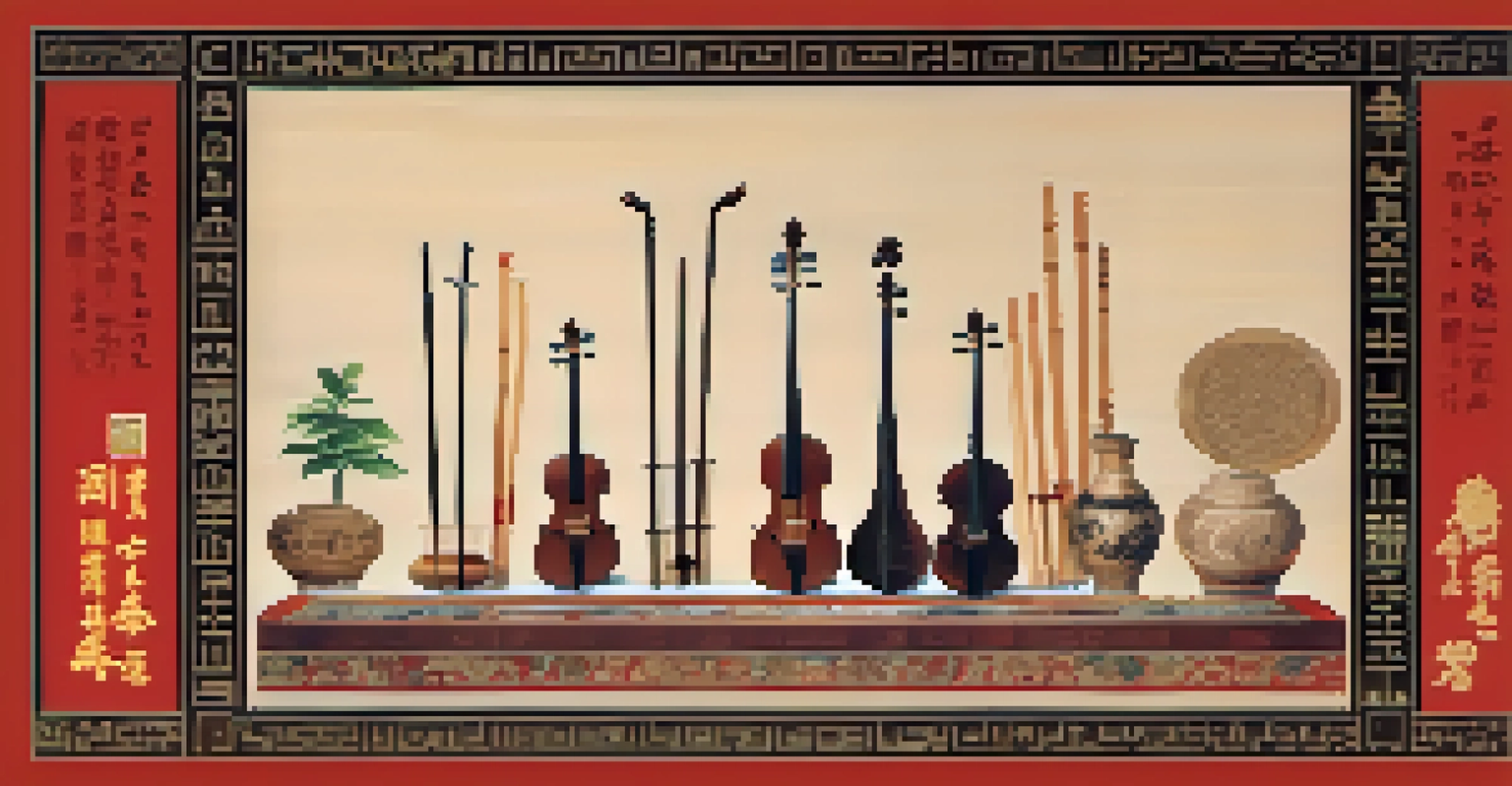The Erhu: A Chinese Two-Stringed Bowed Instrument

Introduction to the Erhu: The Soulful Two-Stringed Instrument
The Erhu, often referred to as the 'Chinese violin,' is a two-stringed bowed instrument with a history that spans over a thousand years. This unique instrument is beloved for its emotive sound and versatility, making it a staple in both traditional and modern Chinese music. The Erhu's design features a long neck and a small resonator body, which contributes to its distinct tonal quality.
Music can change the world because it can change people.
While it may seem simple with its only two strings, the Erhu is capable of producing a wide range of sounds, from melancholic to joyful. It is played by bowing between the strings, allowing musicians to create beautiful melodies that can evoke deep emotions. This simplicity belies the skill required to master the instrument, as the technique can take years to perfect.
The Erhu is not just an instrument; it is a bridge connecting generations of musicians, cultural expressions, and stories. As you listen to the Erhu, you can almost hear the whispers of history, making it a mesmerizing experience for both players and audiences alike.
The Rich History of the Erhu in Chinese Culture
Dating back to the Tang Dynasty (618-907 AD), the Erhu has roots that intertwine with various dynasties throughout Chinese history. Originally a folk instrument, it was often played by traveling musicians and in rural communities, helping to preserve local stories and traditions. As it gained popularity, the Erhu began to find its place in more formal settings, such as the imperial courts.

The cultural significance of the Erhu deepened during the Ming and Qing dynasties, when it became a vital component of Chinese opera and ensemble music. This shift allowed for the evolution of playing techniques and musical styles, enriching the overall sound and versatility of the instrument. With time, it became a symbol of Chinese heritage, often showcased in cultural festivals and celebrations.
Erhu: A Cultural Musical Icon
The Erhu is a two-stringed instrument that symbolizes Chinese heritage, connecting generations through its emotive sound and rich history.
Today, the Erhu represents not only traditional music but also the dynamic evolution of Chinese arts. It has crossed borders, influencing musicians around the world and even being incorporated into various contemporary genres, showcasing its adaptability and timeless appeal.
How the Erhu is Made: Craftsmanship and Materials
Creating an Erhu is an art form in itself, requiring skilled craftsmanship and attention to detail. Traditionally, the body is made from hardwood, such as rosewood or sandalwood, which provides a rich resonance. The strings are typically made of silk or nylon, offering different tonal qualities that impact the overall sound.
The beautiful thing about music is that it connects people.
The construction of the Erhu involves meticulous processes, including carving, polishing, and tuning. Artisans must ensure that the instrument is not only aesthetically pleasing but also acoustically perfect. The resonator, often made from python skin, plays a crucial role in amplifying the sound, making the selection of materials essential.
Each Erhu is unique, reflecting the craftsmanship of its maker and the traditions of its region. This individuality contributes to the charm of the instrument, as no two Erhus sound exactly alike, allowing musicians to express their personal style and emotions through their playing.
Basic Techniques for Playing the Erhu
Playing the Erhu may appear daunting at first, but with practice, anyone can learn the basics. The musician holds the instrument upright, resting it on their lap, while the bow is drawn across the strings to produce sound. Unlike the violin, the Erhu is played without using a fingerboard, which allows for a unique approach to finger placement and intonation.
To create different pitches, players use their left hand to press down on the strings, while the right hand controls the bowing technique. The angle and pressure applied by the bow can significantly alter the sound, allowing for expressive dynamics and articulations. Beginners often start by practicing scales and simple melodies to develop their technique.
Craftsmanship Behind the Erhu
The creation of an Erhu involves meticulous craftsmanship using quality materials, resulting in unique instruments that reflect the maker's skill.
As players become more comfortable, they can explore advanced techniques such as vibrato, glissando, and harmonics. These techniques add depth to the music and showcase the instrument's capability to convey a wide range of emotions, making the learning journey both challenging and rewarding.
The Role of the Erhu in Chinese Music Today
In contemporary music, the Erhu continues to hold a significant role, bridging traditional and modern styles. It is frequently featured in various genres, including pop, rock, and fusion music, allowing it to resonate with a broader audience. Many musicians are now experimenting with the Erhu, creating innovative sounds that blend cultures and musical traditions.
The instrument's presence in film soundtracks and popular media has also helped to popularize its sound globally. The emotive quality of the Erhu can elevate storytelling, enhancing the emotional impact of scenes in movies and television shows. This exposure has sparked interest among younger generations, inspiring them to learn and play the instrument.
Cultural exchange programs and international collaborations have further contributed to the Erhu's global recognition. As musicians from different backgrounds come together to explore this instrument, they create a vibrant tapestry of sounds that reflects the diversity of human experience, showcasing the Erhu as a true ambassador of Chinese culture.
Caring for Your Erhu: Maintenance Tips
Like any musical instrument, proper care and maintenance are essential for preserving the quality and longevity of your Erhu. Regularly checking the tension of the strings and ensuring they are properly tuned can prevent damage and enhance sound quality. It's also important to keep the instrument clean, wiping it down after each use to remove dust and oil from your hands.
The resonator's python skin should be treated with care, as it can be sensitive to temperature and humidity changes. Storing the Erhu in a protective case when not in use will help shield it from environmental factors that could cause deterioration. Additionally, consider applying a light coat of wax to the wooden parts to keep them moisturized and prevent cracking.
Erhu's Modern Musical Influence
Today, the Erhu bridges traditional and contemporary music, finding its place in various genres and inspiring new generations of musicians worldwide.
Every musician should also have a maintenance routine, which may include periodic professional check-ups. A skilled craftsman can address any issues that arise, such as replacing strings or repairing the resonator, ensuring that your Erhu continues to produce beautiful music for years to come.
Conclusion: The Enduring Legacy of the Erhu
The Erhu is more than just a musical instrument; it is a cultural icon that embodies the spirit of Chinese music and tradition. Its rich history, unique sound, and versatility make it a beloved choice for musicians and audiences alike. As it adapts to modern influences, the Erhu continues to bridge the gap between the past and present, captivating hearts across the globe.
Whether played in a traditional ensemble, a contemporary band, or as a solo piece, the Erhu has the power to evoke a wide range of emotions, from nostalgia to joy. This emotional depth is what draws listeners in and keeps them engaged, creating a shared experience that transcends language and culture.

As we celebrate the Erhu and its contributions to music, we invite everyone to explore its beauty and significance. Whether you're a seasoned musician or a curious listener, the Erhu offers a journey into the heart of Chinese musical heritage, inviting you to discover the stories and emotions woven into its strings.